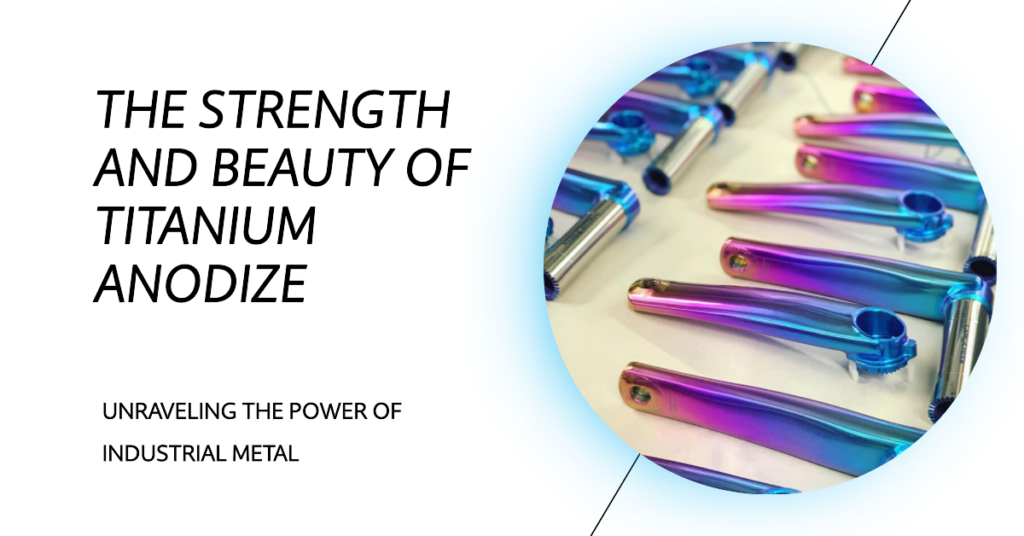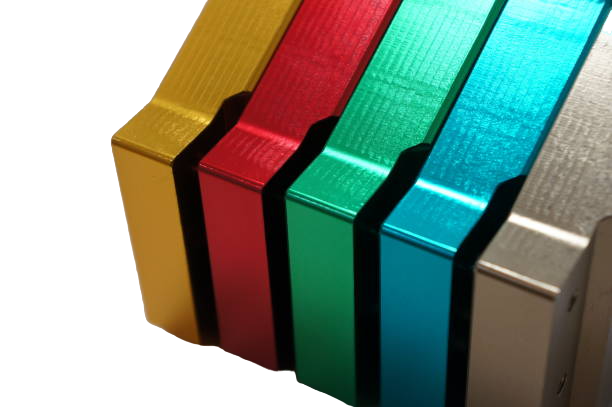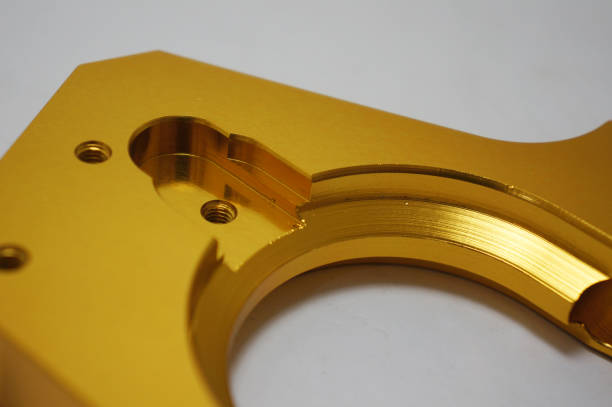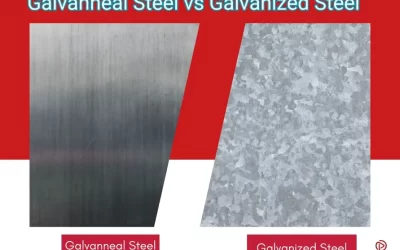
Titanium, a lustrous transition metal with a silver hue, is known for its superior strength-to-weight ratio and excellent corrosion resistance. This metal finds wide-ranging applications, from aerospace to biomedical devices. However, to elevate its properties and aesthetics, titanium undergoes an anodizing process. Titanium anodizing doesn’t merely bolster the metal’s defensive attributes against wear and corrosion, but it also introduces a spectrum of colors without using external pigments or dyes. The science behind these colors and the enhanced features is both fascinating and vital to industries utilizing anodized titanium.
As we embark on this exploration, we’ll delve deep into the anodizing process, understanding how simple electrical manipulations can induce such profound changes in titanium’s surface.
The Science Behind Titanium Anodizing

Anodized titanium parts
Anodizing, a term derived from “anode”, is an electrochemical process that thickens and toughens the naturally occurring protective oxide on titanium’s surface. The science behind titanium anodizing is not only fascinating but also pivotal to many industries that require both robust and visually appealing components.
1. The Basic Electrochemical Reaction
Anodizing is, at its core, a controlled oxidation process. When titanium undergoes anodizing, it acts as the anode in an electrical circuit. Immersed in an electrolytic solution, usually comprising dilute sulfuric acid, an electric current is passed through the solution. As the current flows, oxygen ions from the electrolyte migrate to the titanium’s surface, reacting with it to form a layer of titanium dioxide (TiO2). This layer is harder, more protective, and more porous than the natural oxide layer.
During the anodizing process, the following electrochemical reaction takes place:
Ti + 2H2O → TiO2 + 4H+ + 4e−
2. Thickness and Coloration
One of the remarkable features of titanium anodizing is the range of colors that can be achieved without dyes. The color isn’t a result of pigmentation but rather an optical phenomenon known as interference. As the thickness of the oxide layer increases (controlled by the voltage applied during the anodizing process), different colors become visible due to the way light waves interfere with each other after reflecting off both the outer surface of the oxide layer and the underlying titanium surface.
Table: Titanium Anodizing Color Spectrum vs. Voltage
| Voltage (V) | Color Produced |
|---|---|
| 15-20 | Bronze |
| 25-28 | Dark Blue |
| 29-32 | Light Blue |
| 40-50 | Yellow/Gold |
| 50-60 | Magenta |
| 80-90 | Green |
(Note: The above voltage-to-color relation can vary based on the exact process and conditions.)
3. Importance of Uniformity
The anodizing process demands precision. Any non-uniformity in the applied voltage or inconsistencies in the electrolytic solution can result in uneven coloring or oxide layer thickness. A uniform electric field and meticulous preparation of the titanium surface (free from contaminants) are pivotal for achieving consistent results.
4. Durability of the Oxide Layer
The titanium dioxide layer formed during anodizing is incredibly resilient. Not only does it offer superior corrosion resistance, but it’s also highly resistant to wear and can withstand significant stress. This durability, combined with the non-toxic nature of TiO2, has led to anodized titanium’s widespread usage, especially in wear-prone or human-contact environments like medical implants.
Steps in the Titanium Anodizing Process

Titanium anodizing process
Titanium anodizing is a meticulously sequenced process. While at its core, it’s an electrochemical reaction, the success of the outcome heavily depends on the precision employed at every step. Let’s delve into each phase of the titanium anodizing procedure.
Step 1: Cleaning and Pre-Treatment Before anodizing, it’s crucial to ensure the titanium surface is free from contaminants, oils, or any previous oxide layers.
- Degreasing: Initially, the titanium piece is submerged in a degreasing solution to remove organic residues or oils. Commonly used solvents include acetone or isopropyl alcohol.
- Rinsing: After degreasing, the piece is rinsed thoroughly with distilled or deionized water to eliminate any remnants of the solvent.
- Pickling*:*** The titanium is then immersed in an acid solution, usually a mixture of nitric and hydrofluoric acid, to remove the natural oxide layer and any remaining contaminants. This step also helps in etching the surface, promoting better adhesion of the newly formed oxide layer.
Step 2: Electrolyte Preparation The electrolyte solution, typically dilute sulfuric acid, acts as a medium that facilitates the flow of current during the anodizing process. Its concentration and pH need to be optimized for consistent results.
The acid is mixed with distilled water in the right proportion, ensuring uniform concentration. Then, the electrolyte’s temperature is monitored and controlled. Lower temperatures might result in harder oxide layers.
Step 3: Anodizing This is the central phase where the magic of color and protection happens. The titanium piece is connected to the positive terminal (anode) of the power source, while a cathode (usually made of lead or stainless steel) is connected to the negative terminal. Both the anode (titanium) and cathode are submerged in the electrolyte solution, ensuring they do not touch each other.
A direct current is applied. As the voltage increases, oxygen ions from the electrolyte form an oxide layer on the titanium’s surface. The oxide layer’s thickness, and consequently the color produced, is directly related to the voltage applied.
Step 4: Post-Anodizing Rinsing Once the desired oxide layer thickness (and color) is achieved, the titanium piece is removed from the electrolyte and rinsed. It is immediately rinsed with distilled or deionized water to halt the anodizing process and remove any acid residues.
Step5: Sealing (optional)
Sealing the anodized layer is an optional step that some applications might require for enhanced corrosion resistance. Hydration sealing involves boiling or steaming the piece, which turns the titanium oxide into hydrated titanium oxide, effectively sealing the surface pores. An alternative method is cold sealing, where the piece is immersed in a nickel acetate solution at a lower temperature.
Step 6: Quality Inspection The anodized titanium undergoes various tests to ensure it meets the desired specifications. For example, the oxide layer’s thickness is measured using devices like eddy current gauges and color uniformity and appearance are visually inspected to detect any inconsistencies or defects.
Table: Key Parameters in Titanium Anodizing
| Parameter | Optimal Range | Significance |
|---|---|---|
| Electrolyte Concentration | Usually 10-20% | Determines speed and quality of anodizing. |
| Voltage | 15-100 V | Dictates oxide layer thickness and color. |
| Temperature | 18-24°C (65-75°F) | Affects oxide layer’s hardness and consistency. |
What Are the Benefits of Anodized Titanium?
The process of anodizing titanium, while complex, offers a myriad of advantages that have solidified its position in various industries, from aerospace to jewelry design. Understanding these benefits can provide valuable insight into why so many industries opt for anodized titanium over its non-anodized counterpart.
1. Enhanced Aesthetics One of the most recognizable benefits of titanium anodizing is the vibrant color spectrum it can produce. The array of colors, from gold to purple to blue, is achieved without dyes or pigments. The hue results from light interference on the surface of the oxide layer. An anodizing finish offers customization since different voltages produce different colors, allowing for precision and customization in aesthetic design projects.

Anodized titanium color under different voltage
2. Increased Corrosion Resistance
Anodized titanium exhibits superior resistance against environmental factors, making it ideal for challenging environments. The artificially enhanced oxide layer acts as a barrier, preventing corrosive agents from reaching the base titanium metal. Also, anodized titanium parts last longer in corrosive environments compared to their non-anodized counterparts.
3. Improved Wear Resistance Apart from corrosion, anodized titanium is resistant to wear and abrasion, ensuring a prolonged lifespan for the component. The anodizing process produces a hard, non-porous oxide layer that reduces wear, especially in parts with moving contact.
4. Biocompatibility The medical industry, especially orthopedics, values anodized titanium for its compatibility with the human body. Anodized titanium doesn’t react with the body, making it ideal for implants and other medical devices. Additionally, the process doesn’t introduce any harmful substances, ensuring that the anodized surface remains safe for internal use.
5. Heat Resistance Anodized titanium components can withstand higher temperatures without deforming or losing their color. The oxide layer acts as a barrier, preventing heat damage and retaining the component’s structural integrity.
6. Electrical Insulation The oxide layer produced during anodizing is a poor conductor of electricity, making anodized titanium a good insulator. In electrical applications, anodized titanium can prevent unwanted electrical currents, ensuring safety and proper functionality.
Try Prolean Now!
Challenges in Titanium Anodizing
Despite the numerous advantages of titanium anodizing, the process isn’t without its challenges. Recognizing these issues is essential to ensuring successful anodization.
Table: Challenges in Titanium Anodizing & Their Solutions
| Challenges | Solutions |
|---|---|
| Voltage Fluctuations | Implement a stabilized power supply system to ensure consistent voltages during the process. |
| Electrolyte Composition | Regularly monitor and adjust electrolyte concentrations and pH to maintain ideal conditions. |
| Scratches and Pits | Introduce a pre-anodization surface treatment to minimize visible imperfections. |
| Uneven Surfaces | Use surface leveling techniques or mechanical polishing before anodizing. |
| Handling Care | Train staff on handling techniques and use protective coatings or packaging for the anodized components. |
| Material Costs | Optimize procurement processes, considering bulk purchases or establishing long-term vendor relations. |
| Process Costs | Invest in training to improve efficiency and reduce waste; consider automation for scalability. |
| Waste Disposal | Adopt eco-friendly waste treatment systems or collaborate with certified waste management services. |
Applications of Anodized Titanium

A gold color anodized aluminum parts texture design. CNC parts.
Anodized titanium part
Anodized titanium, with its improved surface properties and distinct color variations, has found applications across various industries. Its unique blend of aesthetics and functionality makes it an indispensable material for both technical and decorative uses.
1. Medical Devices and Implants
Titanium is a widely recognized material in the medical field for its biocompatibility. Anodized titanium exhibits improved osseointegration, which is the direct structural and functional connection between the surface of an implant and bone. This ensures that the implant remains stable and is accepted by the body.
Additionally, anodized titanium tools are non-reflective, a vital feature for surgical tools used under bright operating lights. Additionally, they are corrosion-resistant, making them durable and reliable for medical procedures.
2. Aerospace Manufacturing
Given the demands of the aerospace industry for materials that are both light and strong, titanium fits the bill. Anodized titanium parts, such as fasteners and connectors, benefit from increased wear resistance and corrosion protection. This longevity is crucial for components that are consistently exposed to harsh atmospheric conditions.
Titanium’s high heat resistance, when anodized, is further amplified. This makes it suitable for parts close to or within the engine that are exposed to extreme temperatures.
3.Jewelry and Body Piercings
The vibrant hues achieved through the titanium anodizing process have made it a favorite in the jewelry sector. Anodized titanium can be seen in various jewelry pieces, where its iridescent colors and hypoallergenic properties are highly valued. It does not tarnish, ensuring that the jewelry retains its brilliance over time.
Given its biocompatible nature, anodized titanium is widely used for body jewelry, especially in fresh piercings. Its non-reactive nature ensures minimal chances of allergic reactions or infections.
4. Automotive Manufacturing
In the world of high-performance vehicles and motorsports, every ounce matters. Car enthusiasts often opt for anodized titanium exhaust tips, lug nuts, or even shift knobs. These components not only enhance aesthetics but also provide improved wear resistance.
Furthermore, anodized titanium is utilized for its combination of lightweight properties and strength. In racing, where weight reduction is crucial, these components can make a significant difference.
5. Electronics Manufacturing
As technology continues to advance, the demand for reliable, durable, and miniature components increases. Anodized titanium connectors, especially in high-wear situations, ensure long-lasting connections, vital for device functionality. Many electronic devices, such as smartphones and cameras, have adopted anodized titanium casings for their durability and aesthetic appeal.
6. Sporting Goods
Performance and durability are paramount in the world of sports. The heads of some premium golf clubs are crafted from anodized titanium, offering a balance of lightweight and durability, allowing for a more powerful swing. Also, climbing carabiners and other hardware often employ anodized titanium for its strength-to-weight ratio and corrosion resistance.
Table: Anodized Titanium in Key Industries
| Industry | Application | Benefits |
|---|---|---|
| Medical | Bone Implants, Surgical Tools | Biocompatibility, Non-reflectiveness, Durability |
| Aerospace | Aircraft and Engine Components | Lightweight, Heat and Corrosion Resistance |
| Jewelry | Rings, Body Piercings | Hypoallergenic, Wide Range of Colors |
| Automotive | Accessories, Engine Components | Lightweight, Aesthetics, Wear Resistance |
| Electronics | Connectors, Protective Casings | Durability, Reliable Connections |
| Sporting Goods | Golf Clubs, Mountain Climbing Equipment | Strength-to-weight Ratio, Durability |
Selecting the Right Titanium Anodizing Machine
Choosing the appropriate titanium anodizing machine is crucial to ensuring the effectiveness and consistency of the anodizing process. Several factors come into play when making this decision, with each playing a role in determining the outcome of the anodizing process. Let’s delve deeper into these considerations.
- Purpose and Application
Before investing in any machinery, it’s essential to define the purpose clearly. If you’re running large-scale production or frequent anodizing processes, you’ll need a machine designed to handle higher volumes, perhaps with automated features. On the other hand, smaller operations or occasional anodizing tasks might do well with a manual or semi-automatic machine.
Are you seeking vibrant, decorative colors or more muted, industrial finishes? Different machines can offer varying levels of control over the process, affecting the final appearance of the anodized titanium.
- Machine Size and Configuration
When selecting a titanium anodizing machine, the available space and the size of the items to be anodized are crucial factors. Batch systems can anodize multiple parts at once but in separate batches, while continuous systems can handle a steady stream of parts, usually on a conveyor system. It’s also important to ensure that the machine’s size is suitable for the facility, accounting not just for the machine itself but also for ancillary equipment, safety zones, and operator workspace.
- Electrical Specifications
Anodizing titanium involves electrical currents, so understanding a machine’s electrical specifications is crucial. Different colors and finishes might require varying voltage levels. Ensure the machine offers a range broad enough to achieve your desired outcomes. Machines with consistent, stable power outputs will produce more consistent results. Fluctuations can lead to color inconsistencies or defects in the oxide layer.
- Temperature Control
Temperature can influence the anodizing process. Some high-end machines incorporate cooling systems to maintain the electrolyte at an optimal temperature, which is crucial for consistent results.
Furthermore, maintaining the electrolyte’s temperature might require integrated heating elements in colder climates or settings.
- Safety Features
Safety should always be a top priority. In case of a malfunction or unexpected event, it’s essential to have an easily accessible emergency stop mechanism. Depending on the machine’s design, it might be beneficial to have physical barriers or guards to protect operators from splashes or accidental contact with electrical elements.
- Maintenance and Support
A machine’s longevity and the quality of its output are directly tied to maintenance. Machines designed with maintenance in mind will have components that are easily accessible and replaceable. This not only reduces downtime but can also extend the machine’s life.
Prolean’s Anodizing Services: Performance & Aesthetic
Prolean has consistently stayed ahead in titanium anodizing. By investing in high-end, sophisticated anodizing machines, Prolean ensures precision, consistency, and quality in every project. This commitment to technological advancement allows the company to cater to a wide range of anodizing requirements, from complex industrial components to intricate decorative pieces. Prolean’s titanium machining services are definitely your best choice.
Skilled and Experienced Technicians
A machine is only as good as its operator. Recognizing this, we place a significant emphasis on hiring and training top-tier technicians. With an experienced team that understands the nuances of the anodizing process, we can ensure that each product meets or exceeds client expectations. Continuous training ensures that their technicians are always updated with the latest trends, techniques, and best practices in the industry.
Customized Solutions for Clients
Every client has unique needs, and our approach to anodizing recognizes this diversity. By offering customized solutions tailored to each project’s requirements, Prolean has set itself apart as a leader in the field. This flexibility ensures that regardless of the material, design, or application, clients receive a final product that aligns seamlessly with their vision and specifications.
Conclusion
Titanium anodizing stands out as a unique and innovative process, pivotal in unlocking the metal’s full potential. This procedure not only enhances titanium’s innate durability and corrosion resistance but also introduces a spectrum of aesthetic possibilities through vibrant color outcomes. As industries continuously seek materials that offer both form and function, anodized titanium increasingly becomes a material of choice. From aerospace to jewelry, its applications are vast, underlining its significance. However, achieving perfection in anodization demands precision, expertise, and the right machinery. By understanding its nuances, challenges, and the science behind it, one can appreciate the true art and engineering of titanium anodizing.
Read more: CNC machining of Titanium & Alloys
FAQs
Why is titanium often chosen for anodizing compared to other metals?
Titanium is a popular choice for anodizing because of its unique ability to form a variety of vibrant colors through oxide layer manipulation. Additionally, titanium’s inherent corrosion resistance, biocompatibility, and strength-to-weight ratio make it ideal for numerous applications.
What factors can influence the color outcomes during the titanium anodizing process?
The color achieved during titanium anodizing is primarily influenced by the thickness of the oxide layer. Factors like voltage applied, electrolyte composition, and duration of the process can impact this thickness, thus affecting the final color.
Is the oxide layer formed during anodizing durable?
While the oxide layer is hard and provides enhanced corrosion resistance, it is relatively thin. As such, it can be susceptible to damage like chipping if not handled with care.
How does the purity of titanium affect the anodizing process?
The purity of titanium can influence the consistency and outcome of anodization. Pure titanium is generally preferred as it offers consistent results, whereas alloys might exhibit varied outcomes due to the presence of other metals.
Are there specific industries that benefit most from anodized titanium products?
Numerous industries benefit from anodized titanium due to its unique properties. Notably, aerospace, medical, jewelry, and architectural sectors often employ anodized titanium for both its aesthetic and functional advantages.




Ich brauchte neulich auch eloxiertes Titan für ein Experiment. Glücklicherweise konnte unser Techniker für Oberflächen das sehr schnell herstellen. Besonders die erhöhte Korrosionsbeständigkeit war sehr hilfreich.
Es ist großartig zu hören, dass Ihre Teile durch Titanpolieren korrosionsbeständig werden und das Ergebnis wie erwartet war!
I have used anodizing for titanium components, excellent aesthetic and protection as you said in the article. I will be happy to read more articles regarding titanium anodizing.
Sure, We will publish more of titanium finishing articles in upcoming schedules! Thanks for your comments